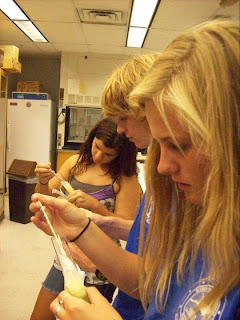Part 2: Science Research Day
On their applications for the Science Research Day, many of the ‘nauts expressed interest in learning about sea turtles. Lucky for us, SCUBAnauts has our very own turtle expert – Rhonda Bailey. Ms. Bailey works for the Florida Wildlife Research Institute in St. Petersburg, focusing on turtle strandings and unusual mortality events. Working with her, the ‘nauts learned how to accurately measure turtles and were able to see a lot of sea turtles that had been killed by the extreme cold weather last winter. They also learned about bivalves from Sarah Stephenson, a scallop expert at FWRI.
 |
| Learning how to open a scallop |
 |
| Using calipers to accurately measure turtles |
Our last stop of the day was over at the USGS. The ‘nauts listened to a presentation by geochemist Jen Flannery. She gave a presentation on the purpose of the USGS (“Science for a changing world”) and went over some of the current projects at the St. Petersburg office. Jen also showed the ‘nauts some of her work on the isotopes found in coral skeletons and plankton that have died and settled in the sediments. The ‘nauts learned about how these basic measurements can be used to determine past climate change and that the earth’s climate has natural variability.
 |
| Listening to Ms. Flannery talk about climate change throughout history and how scientists measure it. |
We got to do some awesome things at the science research day. I really enjoyed all of the events and people we met. My favorite was the plankton tow and identification. I learned a lot during the microbiology with Ms. McDaniel, like separating split pea DNA. Another cool thing was learning about the sea turtles and bivalves. All and all I learned a lot and got to know about specific jobs in the oceanography world.
-Mackenzie
 |
| Mackenzie identifying plankton with Sennai |
On Saturday (the 11th), I was able to participate in an event where we did intriguing labs with different scientists relating to their different professions. We got to make a spectroscope, catch some zooplankton, and I learned how to shuck an oyster!!! We even found out how to extract DNA from a pea plant (we thankfully ate lunch before that one). By participating I gained new knowledge about bivalves, such as how a green scallop is an invasive species, and the differences between sea turtles. Overall it was a lot more interesting than I would have thought and it was way better than just staying at home!
-Jessica
 |
| Jessica doing a plankton tow |
I had a great time at the science research day at USF. We met many scientists and learned about their fields of work. One of my favorite scientists was Maria, she taught us about spectroscopes and we even got to take one we made home. I messed up a lot making mine but in the end it worked! Another scientist I enjoyed hearing from was Sennai. He informed us about plankton - zooplankton are animals and phytoplankton are plants. We even did a plankton tow, collected some, and examined them under a microscope. Lastly I really enjoyed the sea turtles with Rhonda. We learned how to take real stranding report. All in all, I had a really informative and fun day!
-Ashley
 |
| Ashley learning how to measure a sea turtle |












